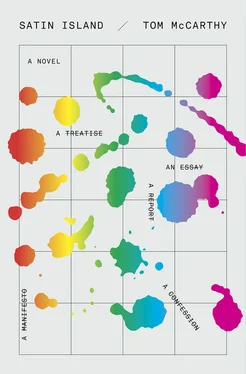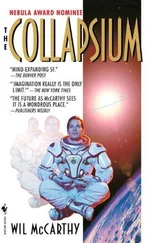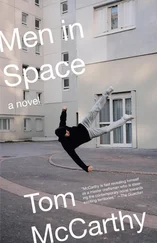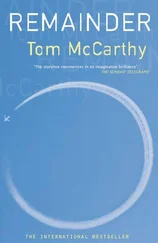5.11Later that evening, I saw Madison again. Again we had sex. Afterwards, lying in bed, I found my mind drifting, once more, among images of oil. I moved through dark and ponderous swells, black-cresting waves and fleck-spattered shingles, before settling among pools in which oil, spent and inert, lay draped over rocks and animals alike. When it covered whole rocks and whole animals, it looked like PVC, like fetish gear. The rescue and clean-up teams’ protective suits looked both perverse and prophylactic at the same time. Offshore, where the waves were breaking, I could see a sluttish Aphrodite frolicking in blackened foam, her face adorned with the look that readers’ wives and models have in dirty magazines.
6.1The following week, I organized a meeting with a bunch of civil servants who were working on Koob-Sassen. The idea was that they’d sit in a room and discuss their sense of what the Project entailed, or, more subtly, implied. We had, in the Company’s offices, a room purpose-built for such discussions. It had loungers, sofas, armchairs, even beanbags — all chosen to induce as relaxed and casual an atmosphere as possible, so that the discussion’s participants could just chew the fat while we watched them through a two-way mirror that formed one of the room’s walls. It never worked that way, of course: people always knew that they were being watched, assessed, recorded. It’s a well-known problem for the anthropologist, first noted by a man named Landsberger: the tribe under observation are aware they’re being observed, and alter their behaviour in view of this fact, often acting out versions of themselves which they think conform to the ethnographer’s own conceptions of them. The technical term for this phenomenon is the Hawthorne effect; but in college we always called it the Cat-in-a-Box Paradox. Our nickname owed its title to the famous hypothesis devised by Erwin Schrödinger, to illustrate the logical consequences of Einstein’s discoveries about the weird behaviour of atoms (we were, in fact, slightly confusing two separate scientific theorems — the Hawthorne effect doesn’t actually have much to do with Schrödinger’s hypothesis; but, not being quantum physicists, we didn’t know or care). Were you (Schrödinger proposed) to seal a cat inside a box in which a vial of gaseous poison — cyanide, say — would either break, thereby killing the cat, or remain intact, thereby leaving it unharmed, depending on which of two apertures an atom chose to jump through — well, the atom would only choose to have jumped through one hole or the other at the moment when the scientist opened up the box to see which it had already jumped through. In other words, the cat would be neither alive nor dead, or rather, both alive and dead, until the scientist, post hoc , peered in to ascertain its live- or deadness.
6.2Thus it was, after a manner, with the subjects I’d observe through the fake mirror. These civil servants knew without being told what was expected of them — not by me, nor even by their bosses, their immediate superiors to whom they could attribute a name and face and rank, but rather by some larger and much vaguer host of assessors, overviewers, judges, lurking on the far side of some other two-way mirror much, much larger, if less obvious, than this one — and were shaping their contributions accordingly. They kept using the word “excitement” (one hundred and eighty-two occurrences over three hours); also “challenge” (one hundred and four); “opportunity” (eighty-nine); “transformation” (seventy-eight); and, as an upscale variant on this last word, “re-configuration” (sixty-three). They reclined in their loungers, stretched their legs out from their beanbags, tried to exude nonchalance and calm — but to me they transmitted tenseness and unease, like anxious cats.
6.3The way iodine works, said Petr when we met later that week in the same pub as last time — what it does, is it recognizes thyroid cancer-cells and zaps them. Say each cancer-cell was like a coin — a certain type, from a specific period, with an exact denomination — well, iodine is trained to spot this coin and melt it back down, take it out of circulation. That sounds pretty straight-forward, I said. You’ll be cured, then. Ah, he replied: in principle it sounds straight-forward. But in practice it turns out to be a little harder than I thought. He paused. How do you mean? I asked. Well, he said, say one of these coins is degraded, or a little different, through some quirk of the mint — the way a machine-part was lying the day that it was pressed, a piece of grit that found its way into the mix, a hundred other permutation-causing factors we could mention: then the iodine can’t recognize it, since these variations haven’t been included in its recognition-software. So the coin, the cancer-cell, not only stays in circulation; it sets up its own mint and prints new copies of itself, each one corrupt, unrecognizable as well; and then these introduce new variations and new mint-quirks of their own, until the iodine has no idea what it’s even supposed to be looking for, throws its hands up, mutters Fuck this! and heads off home. It’s a systems problem, Petr said. If we had a better database, then I’d be out of danger.
6.4One afternoon, while sorting through the transcript of the civil-servant dialogues down in the basement, I poked my head into Daniel’s office again. This time I found him staring at footage that showed hundreds of legs gliding through city streets. I say “gliding” because that’s what they were doing, rather than (say) walking or running. The legs, I realized after a few seconds, belonged to roller-bladers: lots of roller-bladers, skating past the camera — which itself, since it was moving, was (presumably) being held by somebody also on roller-blades. How’s the Great Report coming along? Daniel asked. Oh, you know, I said: it’s coming along slowly; still finding its shape. Look at the way they move, said Daniel, without turning his head towards me. I looked: the bladers’ heads all angled forwards, focused on a spot beyond the picture’s frame, some point on which they were advancing. It wasn’t a race: there was no urgency to their pace. More like a Friday-evening meet-up (it was dark; the streets were lit), with most people just ambling forwards, or sliding from one side of the moving column to the other, or letting the column’s body flow ahead of them a little as they waited for an acquaintance to catch up, or checked their phone for messages, or fiddled with the music they had plugged into their ears.
6.5I shot it in Paris, Daniel said, still facing away from me towards the wall. I’m going there next week, I told him. It’s an MSP, he said, ignoring me. What’s that? I asked. Manifestation sans Plainte , he answered. That’s the legal term for it, as set out in the license granted by the Paris mairie: a Demonstration With No Complaint. Oh, I said; and we watched the footage in silence for a little longer. The roller-bladers kept on gliding by. They didn’t have to make much of an effort to progress, since the street’s surface was quite smooth. This gave them all a kind of languid look. Paris, Daniel explained when I commented on the pavement’s texture, has the smoothest street surface of any major European city. It’s because of sixty-eight, he said, the general uprisings, when revolutionaries pulled up all the cobblestones to throw them at the cops. They even had a slogan stirring them to do this: Underneath the paving stones, the beach! After that, he explained, the authorities replaced the paving stones with tarmac — which had the unforeseen effect of turning the city into a paradise for roller-bladers.
Читать дальше












